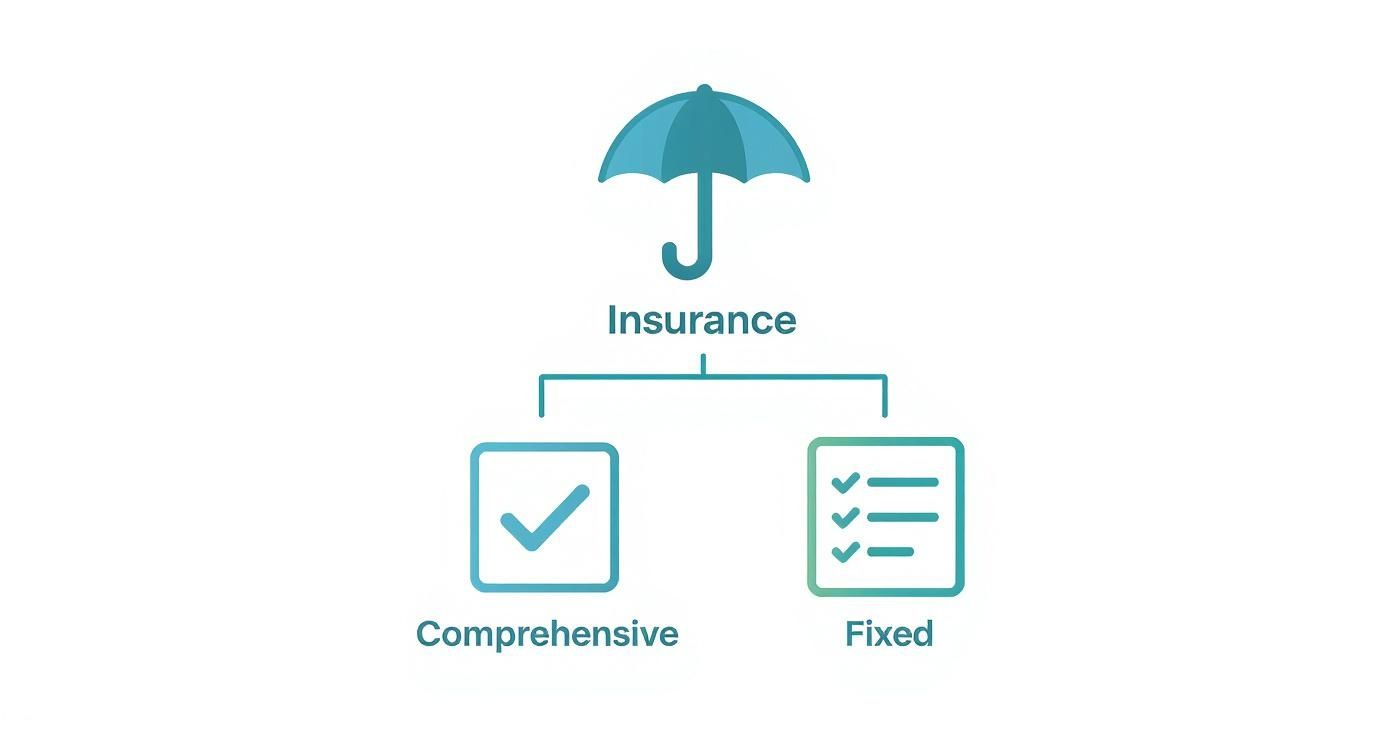Hosting your parents from abroad is a profound pleasure. To ensure this time remains focused on family, not financial contingencies, a specialized visitor insurance plan for parents is an indispensable asset. This is a strategic imperative to safeguard against the formidable cost of medical care in many host countries. This is not generic travel insurance; it is a bespoke financial instrument designed for international visitors, creating a crucial safety net for unexpected health events.
Securing Your Parents' Well-being During Their Visit

You have likely dedicated significant time to orchestrating the perfect visit—curating experiences, stocking the pantry with their preferred comforts, and ensuring their accommodations are impeccable. However, the most critical arrangement you can make is ensuring their health and your family's financial portfolio are rigorously protected.
It is a near certainty that their domestic health plan offers no utility abroad. This leaves a significant and perilous gap in coverage that could expose your family to financially catastrophic out-of-pocket medical expenses.
Consider visitor insurance an integral component of their travel portfolio, as essential as their airline tickets or visa. It is a strategic risk management tool, ensuring a sudden illness or accident does not curtail their visit or impose a debilitating financial burden upon your family.
Acknowledging the Financial Realities
This is not a matter of mere caution; it is an acknowledgement of stark financial realities. A single visit to an emergency room for a seemingly minor issue can readily exceed several thousand dollars. A more serious incident requiring hospitalization can escalate into six-figure costs with alarming speed. This reality renders a robust insurance plan a non-negotiable prerequisite.
Discerning families are increasingly recognizing this necessity. The global travel insurance market was valued at approximately USD 21.1 billion in 2023 and is projected to expand significantly. This trend is a powerful indicator that astute families view this coverage as a critical investment.
Visitor insurance is not an expense; it is an investment in tranquility. It allows you to focus on creating lasting memories, secure in the knowledge that a robust support system is in place should the unexpected occur.
Naturally, ensuring all travel documents are in order is also a priority. Be certain you understand all essential US visa requirements pertinent to their travel. Ultimately, this foresight transforms a potentially high-stress emergency into a manageable event, protecting both your parents' health and your family's financial future.
Decoding Visitor Insurance Plans and Key Terminology
First, it is essential to define visitor insurance precisely. It is a specialized, short-term medical policy engineered for a singular purpose: to cover new illnesses or injuries that arise while your parents are visiting you abroad. It is, quite simply, a financial shield designed to protect your assets from the significant costs of an unfamiliar healthcare system.
Upon reviewing available plans, you will find they are categorized into two principal structures: fixed coverage and comprehensive coverage. The architecture of each is fundamentally different, and this difference directly impacts your premium and, more critically, your potential out-of-pocket exposure should your parents require medical attention.
Fixed Coverage: The À La Carte Option
A fixed coverage plan operates like an à la carte menu. For every conceivable medical service—a physician consultation, a specific laboratory test, a radiological exam—the policy stipulates a pre-defined, fixed dollar amount it will pay. This structure provides predictable and easily understood premiums.
The caveat, however, is significant. You are liable for any costs exceeding these fixed sub-limits. If the plan specifies a $3,000 benefit for a hospital admission but the final invoice totals $5,000, the remaining $2,000 is your responsibility. This is a calculated risk, best suited for individuals prioritizing a lower initial outlay over comprehensive financial protection.
Comprehensive Coverage: The Premier Selection
A comprehensive plan, conversely, is analogous to an all-inclusive package. Once you have satisfied an initial out-of-pocket amount (your deductible), the plan covers a substantial percentage of all eligible medical expenses—typically 75% to 100%—up to the policy's maximum limit.
This approach provides a far more robust safeguard against a catastrophic medical event, which is a tangible risk in countries with high healthcare expenditures. While the premiums are higher, the financial protection afforded is exponentially greater. This is the preferred choice for a prudent, risk-averse strategy. While evaluating these options, a foundational understanding of the Medicare vs Medicaid coverage systems can provide valuable context on the broader healthcare landscape.
The essential takeaway is that comprehensive plans are engineered to insulate your net worth from the volatile and unpredictable costs of a medical emergency. For most, this is the option that delivers genuine peace of mind.
To analyze these plans effectively, a side-by-side comparison is instructive. Let's delineate the core distinctions between a fixed plan and a comprehensive one.
Comparing Fixed vs. Comprehensive Visitor Insurance
| Feature | Fixed Coverage Plan | Comprehensive Coverage Plan |
|---|---|---|
| Coverage Structure | Pays a pre-set, fixed amount for each service | Pays a percentage (75-100%) after deductible |
| Upfront Cost (Premium) | Lower | Higher |
| Out-of-Pocket Risk | High and potentially substantial | Lower and more predictable |
| Best For | Healthy visitors, short-term visits, budget-focused buyers | Maximum asset protection, extended stays, peace of mind |
| Provider Network | May have more restrictions | Typically offers a broader network of physicians/hospitals |
This comparison makes the trade-offs clear. With a fixed plan, you reduce the premium but assume greater financial risk. With a comprehensive plan, you invest more upfront to drastically mitigate your financial exposure in the event of a serious medical incident.
To make a truly informed decision, you must become fluent in the core financial terms governing these policies. For a more detailed examination, review our guide on understanding expat medical insurance policy terms. These are not mere jargon; they are the contractual mechanics that determine your ultimate financial responsibility.
Navigating Pre-Existing Conditions for Traveling Parents
This is the most critical area of diligence when securing visitor insurance. If your parent has a pre-existing health condition, it is the single most important factor to address correctly. This refers to long-term or chronic issues such as hypertension, diabetes, or a known cardiac condition. These represent a significant area of complexity in any insurance contract.
The reason is that standard visitor insurance is designed to cover new medical issues that emerge during their visit—a sudden illness or an unforeseen injury. It is not structured to cover the ongoing management of existing health conditions.
This distinction is paramount. An insurer defines a pre-existing condition as any health issue for which your parent received a diagnosis, medical advice, or treatment prior to the policy's effective date. This means routine consultations, prescription refills, or planned treatments for these known conditions are almost invariably excluded from coverage. Complete transparency regarding their medical history during the application process is not merely advisable; it is mandatory. Non-disclosure can lead to the voiding of the entire policy.
The infographic below illustrates the two primary types of visitor insurance plans, which is crucial for understanding how pre-existing conditions are addressed.

As illustrated, comprehensive plans are structured to manage more complex scenarios, which often includes providing a safety net for emergencies related to pre-existing conditions.
The "Acute Onset" Provision
There is, however, a critical provision found in many superior comprehensive plans: coverage for the acute onset of a pre-existing condition. This is a precise insurance term for a sudden, unexpected exacerbation of a stable, chronic condition that requires immediate medical intervention, occurring without any prior warning or symptoms that would prompt a reasonable person to seek medical care.
To illustrate: a policy will not cover a planned cardiology appointment to manage a known heart condition. However, it may cover an unforeseen, life-threatening heart attack for a parent whose condition was stable and well-managed immediately prior to their travel.
This coverage is a vital safeguard, but it is not a mechanism for obtaining routine care. It is reserved strictly for true medical emergencies. It is absolutely imperative that you understand your policy's exact definitions and exclusions, as a misinterpretation could result in significant financial liability. To gain a deeper understanding, it is wise to read about common medical conditions and policy exclusions that can impact coverage.
With international tourism rebounding—international tourist arrivals increased by 34% in 2023 over the previous year—more families are encountering these specific complexities. This travel boom underscores the growing necessity for robust financial protection against unforeseen medical events, which is precisely the risk that premier visitor insurance is designed to mitigate.
How to Select the Ideal Policy for Your Family
Selecting the appropriate visitor insurance for your parents is not about finding just any plan. It is about constructing a financial safeguard precisely tailored to their specific circumstances. Your objective is for their visit to be about creating memories, unburdened by concerns over medical expenses.
First, you must conduct a realistic assessment of their individual needs. Consider their age, any current health issues, and the planned duration of their stay. A tranquil three-month visit spent primarily at home presents a different risk profile than a six-month sojourn that includes cross-country travel.
Balancing Coverage and Cost
Every policy is anchored by its policy maximum—the absolute limit the insurance company will pay for covered medical expenses. It can be tempting to select a lower maximum to reduce the premium, but this is a perilous strategy in a country with exceptionally high healthcare costs. A single major medical event, such as a heart attack or stroke, can easily generate expenses exceeding $100,000.
Therefore, view a high policy maximum not as a luxury, but as an essential component of protecting your family’s assets. You will pair this with a deductible that your family can comfortably absorb. A higher deductible will lower the premium, but this amount must be paid out-of-pocket before the insurance benefits are triggered.
The image below illustrates a typical comparison interface, allowing you to manipulate these critical variables.
Utilizing such a tool simplifies the process of visualizing the trade-offs between a higher policy maximum, the selected deductible, and the resulting premium.
The Strategic Value of a Provider Network
Beyond the primary financial metrics, the plan’s network structure is critically important. It is highly advisable to select a policy that utilizes a Preferred Provider Organization (PPO) network. A PPO is a consortium of hospitals and physicians that have agreed to provide services to the insurer's clients at pre-negotiated, discounted rates.
When your parents consult a physician within this network, the provider typically bills the insurance company directly. This is a significant advantage. It means you are not required to pay thousands of dollars upfront and await reimbursement during an already stressful period.
Finally, confirm that the policy includes several other essential benefits. These are the components that elevate a good plan to an excellent one:
- Emergency Medical Evacuation: In the event of a serious medical emergency, this covers the cost of transporting your parent to the nearest medical facility adequately equipped for their treatment. This is an indispensable benefit.
- Repatriation of Remains: While unpleasant to contemplate, this is a crucial provision. This benefit covers the substantial costs of returning a parent to their home country should they pass away, ensuring their final wishes are respected without creating a financial crisis for your family.
By methodically evaluating each of these elements, you transition from merely purchasing insurance to making a sophisticated, informed decision that provides genuine peace of mind.
Understanding the Cost and Value of Coverage
Let's be direct: no one enjoys paying for insurance. It is easy to perceive it as merely another expenditure. However, when considering visitor insurance for your parents, a shift in perspective is required. View it not as a cost, but as a strategic investment in the preservation of your family’s financial well-being.
The price of a policy, the premium, is not an arbitrary figure. It is a carefully calculated amount based on several key variables. By understanding the drivers of this cost, you can make intelligent decisions to secure a plan that aligns with your budget while providing the necessary protection for your parents.
What Determines the Price?
The premium for a visitor insurance for parents plan is a dynamic figure, but it is primarily determined by four factors:
- Your Parent's Age: This is the most significant variable. Statistically, the likelihood of requiring medical care increases with age. The premium will reflect this elevated risk profile.
- The Policy Maximum: This is the total coverage liability you are purchasing. A plan with a $100,000 limit will command a higher premium than one with a $50,000 limit because it offers greater protection.
- The Deductible: This is the amount you agree to pay out-of-pocket before the insurer's liability begins. Selecting a higher deductible is a standard method for reducing your premium.
- Length of Their Stay: A six-month policy will cost more than a one-month policy. This is a simple calculation of exposure; a longer coverage period presents a longer window of potential risk.
Placing the Numbers in Perspective
Let's consider a practical example. A policy for a 65-year-old parent visiting for three months with a robust $100,000 maximum. Now, consider a policy for a 75-year-old parent for the same duration, but with only a $50,000 maximum. It may be surprising to learn that the second policy could still be more expensive, solely due to the ten-year age difference.
This is where the true value proposition becomes clear. Your premium is a small, predictable figure. A single emergency room admission for a stroke, by contrast, can easily exceed $120,000 in the U.S. healthcare system. Viewed through this lens, the premium appears far more reasonable.
The real worth of a quality visitor insurance policy is not measured by its cost. It is measured by the catastrophic financial event it helps you avert. It secures your peace of mind, allowing you to enjoy the time with your family without persistent financial anxiety.
This proactive approach is becoming more common. In the United States alone, the travel insurance market generated over USD 5 billion in revenue in 2023. This is no longer a niche product; it signifies a major trend of individuals proactively insulating their international travel from financial shocks. You can read more about these travel insurance market trends to appreciate the prevalence of this strategy.
A Guide to the Medical Claims Process

Purchasing the right visitor insurance for your parents is the first step. The true test of its value occurs when you need to utilize it. Understanding the claims process in advance allows you to focus on what is paramount—your parent's health—rather than becoming ensnared in administrative procedures.
At the onset of a medical issue, your first action should be to contact the insurer's 24/7 assistance line. Consider this team your initial point of contact; they will direct you to in-network facilities and guide you through the immediate next steps, preventing costly errors from the outset.
Initiating and Managing Your Claim
Following initial treatment, the formal claims process begins. This stage requires meticulous organization, as the swift approval and payment of your claim depend on the completeness of your documentation.
The essential paperwork you will almost certainly be required to submit includes:
- A Completed Claim Form: This is the official initiation document provided by your insurance company.
- Itemized Medical Bills: These are critical. They must detail every service and its associated charge. A simple summary of the total cost is insufficient.
- Medical Records: This includes the attending physician’s notes or hospital reports that document the medical necessity of the treatment.
- Proof of Payment: If you paid for any services out-of-pocket, you will need receipts or bank statements to be reimbursed.
Proactive preparation can transform a stressful situation into a manageable task. Always maintain a digital or physical copy of your parent’s insurance ID card, policy number, and the insurer’s emergency contact information in an immediately accessible location.
Understanding Pre-Authorization Requirements
A frequently overlooked step is pre-authorization. For any non-emergency hospitalization or significant medical procedure, you are typically required to obtain the insurance company's approval before the service is rendered.
Neglecting this step can be a costly error. Insurers may reduce the benefit amount or even deny the claim entirely if you fail to secure this prior consent. To better understand this requirement, it is worthwhile to learn how pre-authorisation and direct settlement work within the international health insurance industry.
By familiarizing yourself with these protocols, you can navigate the claims process efficiently, avoiding delays and ensuring the policy delivers the financial support for which it was designed.
Frequently Asked Questions
You are now well-equipped to make an informed decision. Addressing a few final, common questions will ensure you have selected the optimal visitor insurance for your parents.
When Is the Best Time to Buy Visitor Insurance for Parents?
The definitive answer is: before your parents begin their international travel.
Securing the policy before their departure ensures their protection commences the moment their journey begins, eliminating any coverage gaps. This provides peace of mind from day one.
While it is sometimes possible to purchase a policy after their arrival, this is strongly discouraged. Your options become severely limited, and many plans impose a waiting period before certain benefits become active. The most prudent and secure course of action is to arrange the insurance well in advance of their trip.
Can I Extend or Cancel My Parents' Insurance Policy?
Yes, most high-quality visitor insurance plans are designed for flexibility.
If your parents decide to extend their stay, you can typically extend their policy. The key is to submit the extension request before the current coverage term expires. This ensures their protection continues seamlessly.
Regarding cancellations, a full refund is generally available if you cancel before the policy's effective start date. If cancellation is necessary after coverage has begun, you may receive a prorated refund for the unused portion of the premium. However, this is almost always contingent on the condition that no claims have been filed against the policy. Be sure to verify the provider's specific rules on this matter.
The core difference lies in their primary function. Think of travel insurance as a broad package covering trip logistics, while visitor insurance is a specialized medical shield. For parents on an extended visit where health is the main concern, visitor insurance is the more appropriate and critical financial instrument.
This is a critical distinction to comprehend. General "travel insurance" often bundles various coverages—trip cancellation, lost luggage, and flight delays—alongside some medical benefits. In sharp contrast, visitor insurance for parents focuses almost exclusively on providing robust, reliable medical coverage for new illnesses or injuries that may occur during their stay abroad.
At Riviera Expat, we specialize in providing expert guidance on international private medical insurance. Our specialists can help you select a plan that delivers the clarity, control, and confidence you need to protect your family's health and financial security.
Explore your options with us at https://riviera-expat.com.

